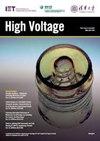共面纳秒脉冲周期表面介质阻挡放电中的热效应和流体动力扰动
IF 4.9
2区 工程技术
Q1 ENGINEERING, ELECTRICAL & ELECTRONIC
引用次数: 0
摘要
对高频脉冲周期纳秒共面介质阻挡放电中的热效应和流体动力扰动进行了实验和数值研究。在脉冲重复频率(PRF)在10和100khz之间的共面开放电极布置中启动放电,电极间隙为10mm。采用增强电荷耦合器件(ICCD)成像、空间分辨发射光谱、光学吸收法和背景取向纹影技术分别测量了不同重复频率下的放电形貌、热释放、臭氧分布和折射率摄动。随着脉冲频率和脉冲数的增加,放电形貌由10 kHz时的准均匀结构转变为丝状结构,且接地电极附近气体温度升高。反过来,气体加热在很大程度上决定了臭氧的动力学。对流量特性和水动力扰动进行了数值模拟和分析。暴露接地电极的存在有利于正极和负极放电之间的连接。在余辉阶段,由于电荷分离,大量的正电荷聚集在两个暴露电极附近,产生强大的体力,从而触发气流的爆发。本文章由计算机程序翻译,如有差异,请以英文原文为准。
Thermal Effect and Hydrodynamic Perturbation in a Coplanar Nanosecond Pulse Periodic Surface Dielectric Barrier Discharge
The thermal effect and hydrodynamic perturbation within a high-frequency pulse-periodic nanosecond coplanar surface dielectric barrier discharge (ncSDBD), are studied experimentally and numerically. The discharge is initiated in a coplanar open electrodes arrangement with 10 mm inter-electrode gap for pulse repetition frequencies (PRF) between 10 and 100 kHz. The discharge morphology, heat release, ozone distribution and refractive index perturbation with different repetition frequency are measured by intensified charge-coupled device (ICCD) imaging, spatially resolved emission spectroscopy, optical absorption methods and the background-oriented schlieren technique, respectively. With the increase of frequency and number of pulses, the discharge morphology changes from quasi-uniform structure at 10 kHz to filamentary mode, and a higher gas temperature is observed near the grounded electrode. In turn, the gas heating largely determines the dynamics of ozone. The discharge characteristics and hydrodynamic perturbation are modelled and analysed numerically. The existence of the exposed grounded electrode facilitates the connection between the positive and negative discharges. During the afterglow phase, a large amount of positive charge accumulates near the two exposed electrodes due to charge separation, resulting in a strong body force, which triggers the blowing up of the flow.
求助全文
通过发布文献求助,成功后即可免费获取论文全文。
去求助
来源期刊

High Voltage
Energy-Energy Engineering and Power Technology
CiteScore
9.60
自引率
27.30%
发文量
97
审稿时长
21 weeks
期刊介绍:
High Voltage aims to attract original research papers and review articles. The scope covers high-voltage power engineering and high voltage applications, including experimental, computational (including simulation and modelling) and theoretical studies, which include:
Electrical Insulation
● Outdoor, indoor, solid, liquid and gas insulation
● Transient voltages and overvoltage protection
● Nano-dielectrics and new insulation materials
● Condition monitoring and maintenance
Discharge and plasmas, pulsed power
● Electrical discharge, plasma generation and applications
● Interactions of plasma with surfaces
● Pulsed power science and technology
High-field effects
● Computation, measurements of Intensive Electromagnetic Field
● Electromagnetic compatibility
● Biomedical effects
● Environmental effects and protection
High Voltage Engineering
● Design problems, testing and measuring techniques
● Equipment development and asset management
● Smart Grid, live line working
● AC/DC power electronics
● UHV power transmission
Special Issues. Call for papers:
Interface Charging Phenomena for Dielectric Materials - https://digital-library.theiet.org/files/HVE_CFP_ICP.pdf
Emerging Materials For High Voltage Applications - https://digital-library.theiet.org/files/HVE_CFP_EMHVA.pdf
 求助内容:
求助内容: 应助结果提醒方式:
应助结果提醒方式:


